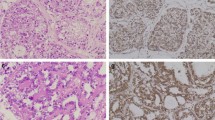Summary
A human cell line has been established from a renal adenocarcinoma rib metastasis of a 58-y-old male. This cell line has been maintained in continuous culture for 20 mo. through more than 50 passages. It displays simulataneous expression of the intermediate filaments cytokeratin and vimentin. Flow cytometric analysis of DNA content reveals a major hyperdiploid population.
Similar content being viewed by others
References
Giard, D. J.; Aaronson, S. A.; Todardo, G. J., et al. In vitro cultivation of human tumors: Establishment of cell lines derived from a series of solid tumors. JNCI 51: 1417–1423; 1973.
Ishihara, T.; Moore, G. E.; Sandberg, A. A. The in vitro chromosome constitution of cells from human tumors. Cancer Res. 22: 375–379; 1962.
Fogh, J.; Trempe, G. New human tumor cell lines. In: Fogh, J., ed. Human tumor cells in vitro. New York: Plenum Publishing; 1975: 115–154.
Williams R. D.; Elliot, A. Y.; Stein, N., et al. In vitro cultivation of human renal cell cancer. II. Characterization of cell lines. In Vitro 14: 779–786; 1978.
Hoehn, W.; Schroeder, F. H. Renal cell carcinoma: two new cell lines and a serially transplantable nude mouse tumor (NC65)-Preliminary report. Invest. Urol. 16: 106–112; 1978.
Katzuoka, Y. Functional and morphological observation of human renal cell carcinoma utilizing nude mice and cell culture system. Jpn. J. Urol. 69: 285–303; 1978.
Komatsubara, S. Establishment of a new cell line (NRC-12) derived from a human renal cell carcinoma and its characterization. Jpn. J. Urol. 69: 1535–1542; 1978.
Matsuda, M.; Osafune, M.; Nakano, E., et al. Characterization of an established cell line from human renal carcinoma. Cancer Res. 39: 4694–4699; 1979.
Naito, S.; Kanomori, T.; Hisano, S., et al. Human renal cell carcinoma: establishment and characterization of two new cell lines. J. Urol. 128: 1117–1121; 1982.
Shrivastav, S.; Sharief, Y.; Day, J., et al. Establishment and characterization of a cell line (SS78) from a human renal cell carcinoma. In Vitro 17: 1117–1124; 1981.
Kinouchi, T.; Kotake, T.; Mori, Y., et al. Human renal cell carcinoma: Establishment and characterization of a new cell line (OS-RC-2). In Vitro 21: 195–199; 1985.
Lazarides, E. Intermediate filaments: a chemically heterogeneous, developmentally regulated class of proteins. Ann. Rev. Biochem. 51: 219–250; 1982.
Feitz, W. F. J.; Karthaus, H. F. M.; Beck, H. L. M., et al. Tissue-specific markers in flow cytometry of urological cancers. II. Cytokeratin and vimentin in renal-cell tumors. Int. J. Cancer 37: 201–207; 1986.
Waldherr, R.; Schwechheimer, K. Co-expression of cytokeratin and vimentin intermediate-sized filaments in renal cell carcinomas. Virchows Arch (Pathol Anat) 408: 15–27; 1985.
Holthofer H.; Miettinen, A.; Lehto, V.-P., et al. A fluorescence microscopic study with kidney-specific antibodies, antiintermediate filament antibodies, and lectins. Lab. Invest. 49: 317–326; 1983.
Ramaekers, F. C. S.; Moesker, O.; Huysmans, A., et al. Intermediate filament proteins in the study of tumor heterogeneity: an in-depth study of tumors of the urinary and respiratory tracts. Ann. NY Acad. Sci. 615–634; 1986.
Holthofer, H.; Miettinen, A.; Lehto, V.-P., et al. Expression of vimentin and cytokeratin types of intermediate filament proteins in developing and adult human kidneys. Lab. Invest. 50: 552–559; 1984.
Lehtonen, E.; Virtanen, I.; Saxen, L. Reorganization of intermediate filament cytoskeleton in induced metanephric mesenchyme cells is independent of tubule morphogenesis. Dev. Biol. 108: 481–490; 1985.
Tanenbaum, M. Ultrastructural pathology of human renal cell tumors. Pathol. Ann. 6: 249–277; 1971.
Bornstein, M. B. Reconstituted rat-tail collagen used as substrate for tissue cultures on coverlips in maximow slides and roller tubes. Lab. Invest. 7: 134–137; 1958.
Laemmli, U. K. Cleavage of structural proteins during assembly of the head of bacteriophage T4. Nature 227: 680–685; 1970.
Towbin, H.; Staehelin, T.; Gordon, J. Electrophoretic transfer of roteins from polyacrylamide gels to nitrocellulose sheets: procedure and some applications. Proc. Natl. Acad. Sci. USA 76: 4350–4354; 1979.
Steinert, P.; Zackroff, R.; Anyardi-Whitman, M., et al. Isolation and characterization of intermediate filaments. In: Wilson, L. A., ed. Methods in cell biology, New York: Academic Press; 1982: 399–419.
Deitch, A. D.; Law, H.; deVere White, R. A stable propidium iodide staining procedure for flow cytometry. J. Histochem. Cytochem. 30: 967–972; 1982.
Chan, R.; Rossitto, P. V.; Edwards, B. F., et al. Presence of proteolytically processed keratins in the culture medium of MCF-7 cells. Cancer Res. 46: 6353–6359; 1986.
deVere White, R. W.; Deitch, A. D. The role of flow cytometry in urological disease. Semin. Urol. 3: 132–145; 1985.
Frankfort, O. S.; Huber, R. P. Clinical applications of DNA flow cytometry for bladder tumors. Urology 33: 29–34; 1984.
Tiubukait, B. Flow cytometry in surgical pathology and cytology of tumors of the genito-urinary tract. Adv. Clin. Cytol. 2: 163–189; 1985.
Melamed, M. R.; Klein, F. A. Flow cytometry of urinary bladder irrigation specimens. Hum. Pathol. 15: 302–305; 1984.
Imam, A.; Taylor, C. Application of immunohistochemical methods in the diagnosis of malignant disease. Cancer Invest. 3: 339–359; 1985.
Ramaekers, F. C. S.; Haag, D.; Kant, A., et al. Coexpression of keratin- and vimentin-type intermediate filaments in human metastatic carcinoma cells. Proc. Natl. Acad. Sci. USA 80: 2618–2622; 1983.
Gunther, A.; Kinjo, M.; Winter, H., et al. Differential expression of intermediate-filament proteins in murine sarcoma 180 ascites or solid tumor. Cancer Res. 44: 2590–2594; 1984.
Author information
Authors and Affiliations
Additional information
This work was supported in part by a grant from Triton Biosciences, Inc.
Rights and permissions
About this article
Cite this article
Gumerlock, P.H., Edwards, B.F., Deitch, A.D. et al. Human renal clear cell carcinoma: Establishment and characterization of a new cell line (G-2101). In Vitro Cell Dev Biol 24, 429–434 (1988). https://doi.org/10.1007/BF02628494
Received:
Accepted:
Issue Date:
DOI: https://doi.org/10.1007/BF02628494




